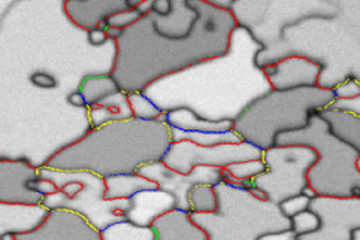All genres
281.
Talk
Novel Approaches for Characterizing the Delamination resistance of Organic Coatings. 230th ECS Meeting-PRiME 2016, Honolulu, HI, USA (2016)
282.
Talk
Metal/Nano-Container Composite Coatings for Long-Term Reliable Self-Healing Capability. 6th Annual World Congress of Nano Science & Technology – Nano S&T 2016, Singapur, Singapur (2016)
283.
Talk
Coatings for intelligent corrosion protection: self-healing of macroscopic defects. 7th Kurt-Schwabe-Symposium, Mittweida, Germany (2016)
284.
Talk
Conducting polymer based anticorrosion composite coatings – acceleration of the trigger signal spreading. 7th Kurt-Schwabe-Symposium 2016, Mittweida, Germany (2016)
285.
Talk
Using a Novel In-situ/Operando Chemical Cell to Investigate Surface Reactions such as the Reduction of Oxygen and Surface Oxides. 11th International Symposium on Electrochemical Micro & Nanosystem Technologies (EMNT2016), Brussels, Belgium (2016)
286.
Talk
A Novel Potentiometric Approach to a Quantitative Characterization of Oxygen Reduction Kinetics at Buried Interfaces. 11th International Symposium on Electrochemical Micro & Nanosystem Technologies (EMNT2016), Brussels, Belgium (2016)
287.
Talk
Dual payload capsules for corrosion protection coatings – importance of the electronic coupling at the metal/capsules interface. 67th Annual Meeting of the International Society of Electrochemistry (ISE) 2016, The Hague, The Netherlands (2016)
288.
Talk
Surface Modification of Iron With Grafted Hydrophobic Acrylic Polymers and Study of Their Delamination Kinetics. Polymers and Organic Chemistry POC16, Hersonissos (Crete), Greece (2016)
289.
Talk
Atomic diffusion induced degradation in bimetallic layer coated cemented tungsten carbide. APT & M 2016 Conference, Gyeongju, Korea (2016)
290.
Talk
Nanokapseln für den intelligenten Korrosionsschutz – eine kritische Übersicht. GfKORR- Nanoskalige Korrosionsschutzsysteme – Anspruch und Wirklichkeit, Dechema, Frankfurt, Germany (2016)
291.
Talk
Die Rasterkelvinsonde: neue Entwicklungen für die Charakterisierung von Korrosionsschutzbeschichtungen. 7. Korrosionsschutz-Symposium, Kloster Irsee, Germany (2016)
292.
Talk
Conducting Polymers for Intelligent Self-Healing Coatings. Energy Materials Nanotechnology (EMN) Meeting on Polymer, Hongkong, Hongkong (2016)
293.
Talk
Characterization of Oxides in the Heat Affected Zone. Welding Workshop “Guidelines for use of welded stainless steel in corrosive environments” at TWI, Granta Park, Cambridge, UK (2016)
294.
Talk
On the Role of δ phase in Hydrogen Embrittlement of Alloy 718: Multi-scale H-Mapping in a Ni–Nb Model Alloy. SINTEF and NTNU's Environmental Assisted Cracking (SNEAC) workshop, Trondheim, Norway (2016)
295.
Talk
Stimuli-responsive capsules for self-healing in corrosion protection. DFG SPP 1568 "Design and Generic Principles of Self-Healing Materials", Jena, Germany (2015)
296.
Talk
Investigating the Role of Self-Healing Kinetics at the Delaminating Interface. 228th ECS Meeting, Phoenix, AZ, USA (2015)
297.
Talk
Internal oxidation of high strength steels during short-term annealing: Observation of unexpectedly fast progress of the internal oxidation and first tentative model. EFC Workshop High Temperature Corrosion, Frankfurt, Germany (2015)
298.
Talk
Coatings for intelligent self-healing of macroscopic defects: first results and the major challenges. eMRS, Symposium „Self-Healing Materials", Warsaw, Poland (2015)
299.
Talk
Selbstheilende Beschichtungen für den Korrosionsschutz: Ein kritischer Überblick. 28. Sitzung des AK “Korrosionsschutz durch Beschichtungen”, GfKorr, Frankfurt, Germany (2014)
300.
Talk
“Green” encapsulation of corrosion inhibitors for smart coatings. EUROCORR 2014, Pisa, Italy (2014)











